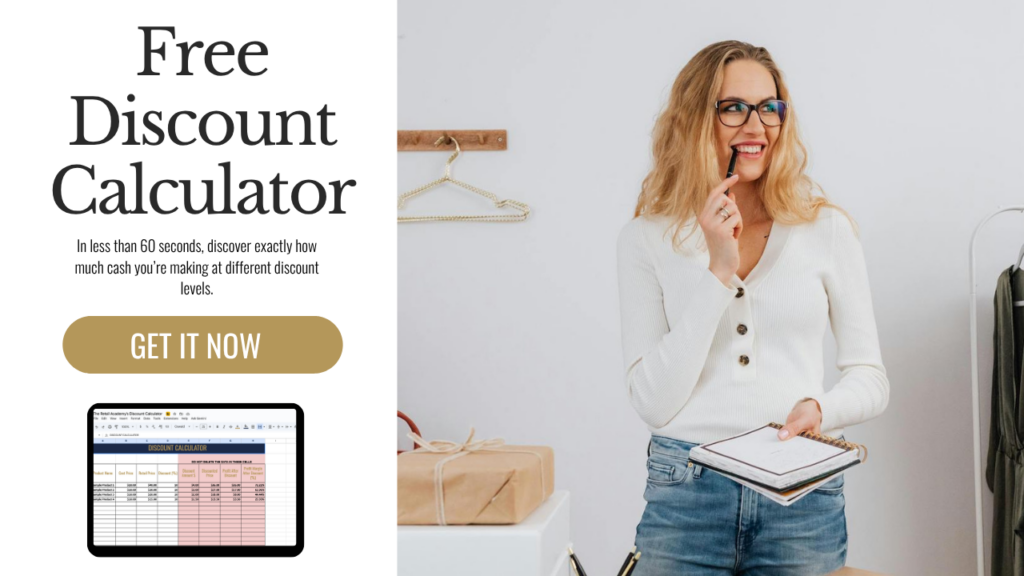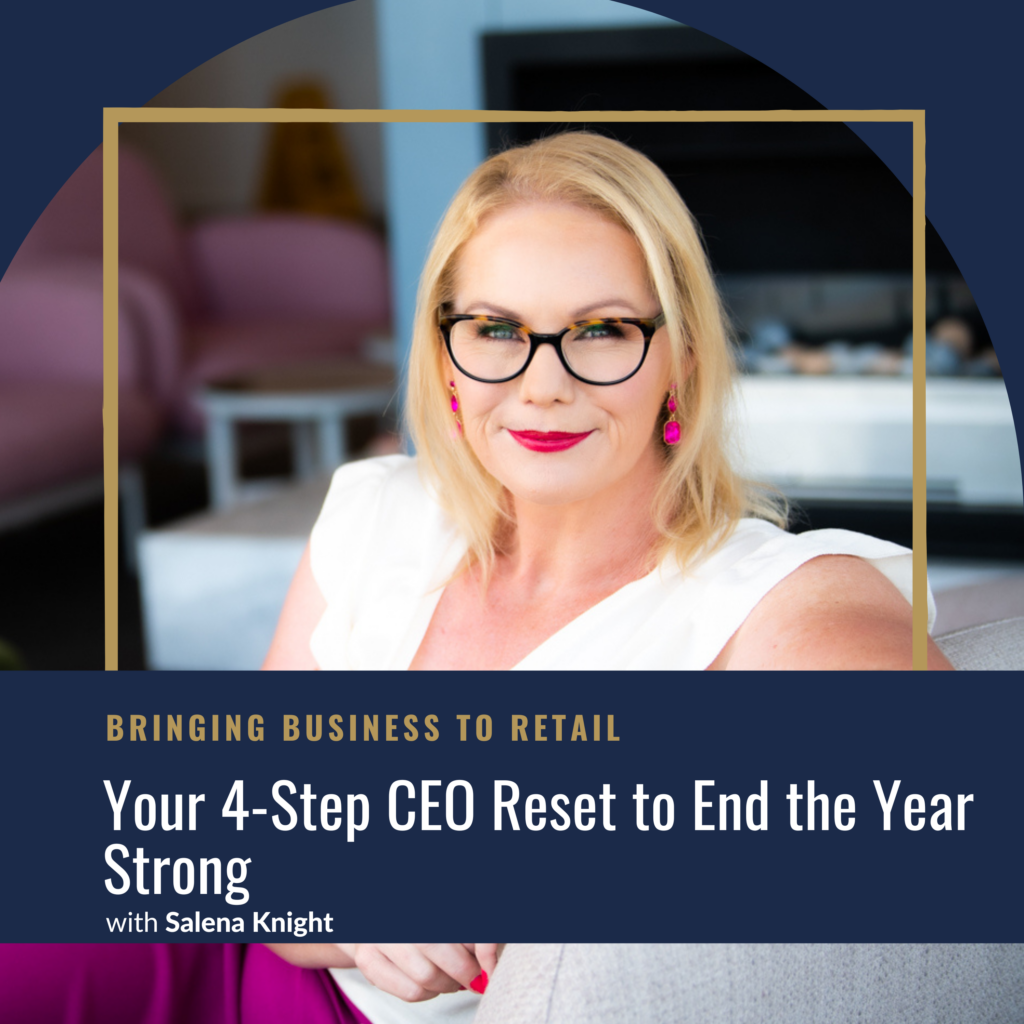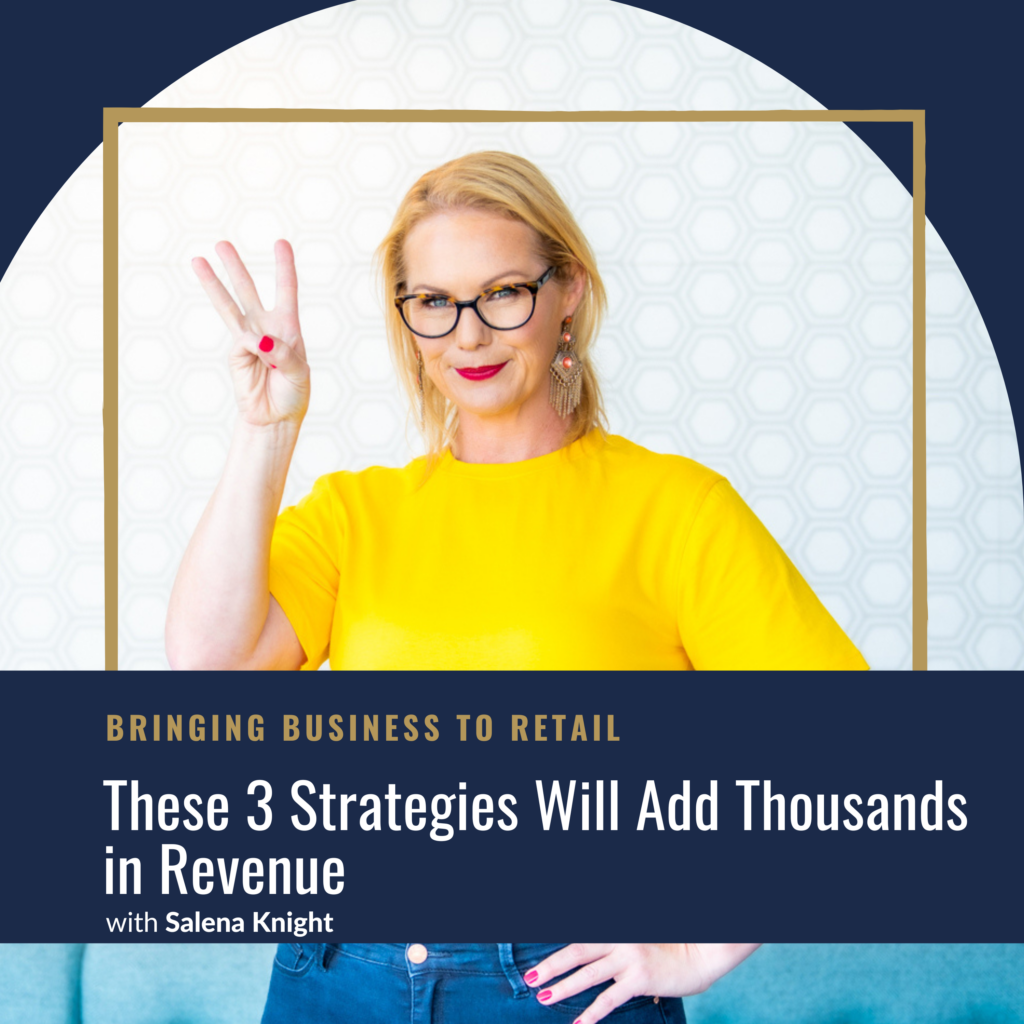
SHOW NOTES
I still remember my first holiday season as a store owner like it was yesterday.
I’d just opened my bricks-and-mortar store that September — I even spent my daughter’s first birthday painting the walls!
Despite my business degree, nothing could have prepared me for the reality of Q4 in retail. By December 15th, 2008, my store was full, customers were browsing, but… they were leaving empty-handed.
That was my first painful lesson: having “good products” isn’t enough — you need the right products for the holiday season.
In this episode of Bringing Business to Retail, I’m sharing the exact 5-step framework I wish I’d had back then — the one that would have saved me tens of thousands of dollars and turned my holiday season into the most profitable time of year, not the most frustrating.
Here’s what we’re covering:
- Why you can’t wait until November to think about your product selection — and how your decisions today are already determining your Q4 revenue.
- The three biggest product mix mistakes I made (and most retailers still make every single year).
- How to run The Gift Test on your current inventory and instantly spot what will (and won’t) sell.
- The price point analysis that ensures you have something perfect for every type of buyer.
- How to clear space and free up cash flow for holiday best-sellers before it’s too late.
- The quick last-minute adjustments you can make right now to avoid leaving money on the table.
If you’re staring at your shelves or scrolling through your online catalog wondering if you have the right products for Q4 — this episode is for you.
Your holiday success isn’t about luck. It’s about strategy. Listen in, take notes, and start implementing this framework today so you can head into the busiest season of the year with confidence.
🎧 Listen now and get ready to have your most profitable holiday season yet.
See you in the episode,
Sal
LISTEN NOW on The Bringing Business To Retail Podcast
When I opened my first bricks and mortar store, I did it in September. And I remember because I spent my daughter's first birthday painting that shop, I literally dropped her over the road at the park. There was a park at the beach and all of my family were there for her first birthday and I dropped her over there.
My husband and I, you know, we had, we said hellos and all that kind of stuff, and then we just left her to hang out with her family, who she didn't see very often. And then we came back after a couple of hours of painting the shop. Now, despite the years that I spent getting a business degree and the tens of thousands of dollars, nothing prepared me for my first, or if I'm honest, maybe even my second holiday season.
Hey there, and welcome to the Bringing Business to Retail podcast. We took all about strategies to make more money in your retail or e-commerce business. I'm Selena Knight, and I need to tell you about one of the most painful lessons that I learned in my retail business. And it's one of those ones where when you look back, you kind of think, oh, I really should have known this.
So picture this, it's December 15th, 2009, and my store is busy. People are coming in, they're looking for last minute holiday gifts. I should be celebrating. I mean, heck, I just opened my store in September. This is my first Christmas, and people are in the store. But instead, I'm watching customer after customer walk around the store, pick things up, put them back down, and leave empty handed.
I remember one woman who spent, uh, I'm gonna say a good 20 minutes in my store, and my store wasn't huge, so 20 minutes was a long time. And she was clearly looking for something special. I asked her what it was, and it was a gift for her daughter who was due to have her first baby. So she was going to be a grandma for the first time, and she picked up product after product and then she would look at them and then she would put them back down again very, very carefully, and I could see the disappointment in her face.
And finally she came to the counter and she said, do you have anything that feels a bit more Christmas gifty? And that's when it hit me. I mean, my store was full of beautiful products that people love to buy for themselves and even for other people throughout the year. But during the holiday season when people were shopping with a completely different mindset, my product selection was all wrong.
That's when it hit me. My store was full of beautiful products that people love to buy for themselves and as gifts throughout the year. But during the holiday season when people were shopping with a completely different mindset, my product selection was all wrong. And so I'd scrambled to try and put some of our best sellers into a holiday gifty kind of light.
But at the end of the day, it was too late. That woman walked out empty handed, and you know what? She wasn't the only one. I didn't know any better, but in hindsight, I can see that this happened over and over again during what should have been my most profitable season. But here's what I didn't understand then, that I desperately wish I would have, and that is that the product decisions that you are making today, this week, this month, are going to determine your holiday revenue.
And if you get it wrong, no amount of promotion or holiday spirit is going to save those Q4 numbers. I wanna tell you why most people get this completely backwards because throughout the year we stock products that are based on what our regular customers want. So we choose items that solve everyday problems that fit into people's regular buying routines that make their everyday lives better, and that makes perfect sense for January through to September.
But come October, you're not selling to the same customer anymore. You're selling to gift buyers. And gift buyers have a completely different psychology. Your regular customer might love that practical storage solution or that everyday skincare routine, but somebody who is shopping for a gift, they want something that feels special, luxurious, indulgent.
They want something that the recipient wouldn't necessarily buy for themselves. I, as I mentioned, learned this the hard way because in my baby product store, I had shelves full of practical items. I mean, I'm a practical kind of person, and I figured that the people who came there just wanted the stuff that they needed for their babies.
And as new moms, those sorts of things were, you know, bottle brushes, rash creams, sleeping sacks, feeding bibs, all of those things that new parents could want. All of the essentials that flew off the shelves throughout the year. But during the holidays, crickets because gift buyers weren't looking for practical, they were looking for special.
Hmm. Yeah. It took me a while to work that one out, but meanwhile, I would watch the big box store that was down the road in the mall, absolutely filled with customers at buying, and it didn't make sense to me then, but I get it now. The difference was their product mix. While I had shelves full of your Tuesday afternoon necessities, they had the perfect gift products.
They had luxurious baby blankets instead of practical ones. They had beautiful keepsake boxes instead of everyday essentials. I mean, I used to look at those things thinking who buys them? The answer is the people who were going to the big box stores because I didn't have them. They wanted the gift sets that looked expensive and thoughtful instead of individual products that just look like a shopping list full of items.
So here's what I didn't understand about timing. You cannot wait until November to think about your holiday product mix by then. It's just too late. Your cash is tied up in inventory that may or may not move, and you don't have the budget or the shelf space for what will actually sell. The product decisions that determine your holiday success need to happen now in September, October at the latest, because this is when you need to be thinking, what do I have that would make someone say, this is the perfect gift.
What's missing in my product range? What do I need to add and what do I need to clear out to make room for the winners? But here's where most retailers get stuck. They look at their current inventory just like I did, and they think. Well, I've got stuff, I've got products and people need gifts. Like they can just buy what I've got.
But that's like trying to serve a five course dinner with some bread and some ham. I mean, you might have food, but you don't have the right food for the occasion. So let me walk you through three massive mistakes that I made with my product selection before we we jump into my five step framework for choosing the right products.
Because these three mistakes I see retailers making pretty much every single year. So mistake number one is the pretty but not gift worthy trap. So I had a store full of products that looked great on social media that customers loved for themselves, loved to give us gifts during the year, but that failed that special holiday gift test.
Miserably. My organic cotton onesies were adorable and they were beautiful and they were well-made and they were soft, but they look like something that you could pick up. During a target run, not something you would present as a thoughtful gift. My practical changing pad covers were a necessity, but they weren't exciting.
And meanwhile, I didn't have enough of the products that passed that gifty test. The gorgeous handmade blankets, the expensive wooden toys, the luxury bath sets that came in as elegant packaging. I remember when I worked this out, and it wasn't in the first year. It wasn't even in the second year, but I remember thinking back and calculating that this disaster had cost me probably $15,000 worth of perfectly good inventory that didn't move during Q4.
Meanwhile, I was running out of the few very gift worthy items that I did have. I was literally calling up suppliers saying, can I drive over there and get more? Because I was turning customers away because I didn't have enough of what they wanted to buy in the holiday season. So mistake number one, the pretty, but not gift worthy items.
Mistake number two is what I call the dead stock cashflow trap. I mean, honestly. As I recount this to you, I honestly wanna slap myself because this one seems like a no brainer dead stock. It doesn't just sit there taking up space during the holidays. It actively costs you money because it's occupying real estate where best sellers should be.
Because most of my products were year round sellers. I had slow moving products taking up prime shelf space during the busiest holiday season of the year. Products that I should have cleared out months earlier, but they were blocking my customers from finding the gift worthy items. But the real killer was cashflow.
I had thousands of dollars tied up in inventory that wasn't moving during the holiday season, which meant I couldn't invest in the products that would actually generate the revenue over the holidays. I was stuck with what I had instead of being able to pivot to what I actually needed. I would watch other retailers do flash sales in September and October to clear, slow moving inventory.
And honestly, I would laugh at them. I mean, why were they ditching stuff that sold all year round? Note to self, big box stores have a reason for everything and we should learn from them. They would sell off that old stock and then they would use that cash to bring in their holiday specific products.
Meanwhile, I was holding onto everything I was hoping it would eventually sell. I was just gonna put it in the storeroom and bring it out next year, and I was missing the opportunity to optimize my product mix for the season. Okay, so they're pretty, but not gift worthy. Ugh, own the dead stock cashflow trap.
Mistake number three is the price point gap crisis. Now, this one really hurt me because I didn't actually realize until customers started telling me this directly. I mean, you know, you sit there and you think, again, this feels like retail 1 0 1. Why does nobody tell us this? So I had plenty of products.
Remember, I love being an affordable store. Plenty of products 39 99 and under because that was my sweet spot during the, the rest of the year. And then they kind of went into the 90 and a hundred dollars. I had almost nothing in this crucial 40 to $80 range where most gift buyers want to shop. So people would come in and they'd wanna spend 50, 60, $70 on a gift, but they couldn't find anything that felt substantial enough for their budget.
Remember, when people are giving gifts, quite often we want like more, we want to give Biggers better. So they would either buy something cheaper, feel like it wasn't enough, or they would shop elsewhere for something more impressive. I remember one customer who was looking for, I'm gonna say about a $75 baby shower gift, and this was in the Christmas time, so she wanted it to be that little bit more special.
Now, she loved our premium skincare set. That was $95, but that was over her budget. And then our $45 gift set looked two basic for what she wanted to give. She didn't end up buying anything. She ended up going somewhere else because she just wanted an easy to get gift that was in her price point that made her look like a really good gift giver.
And that's when I realized I wasn't just missing sales, I was missing an entire customer segment because my price architecture was wrong for gift giving in the holiday season. Now the math on these disasters. I'm gonna say it was like devastating. It would've been game changing. If I would've realized this early, I probably lost 30 to $50,000 in missed revenue because I didn't understand that holiday shopping requires a completely different product strategy.
So I promised you a five step framework that I wish I had back then, and this is how you're going to audit your current product mix and fix any gaps before it's too late. So we've understood those three mistakes that we make. But here is the five step framework. Step one, the gift test. I want you to walk through your store, scroll through your website with fresh eyes for every product.
Ask yourself, if someone gave this to me as a gift, how would I feel? Excited, grateful, or what I think. Hmm. Okay. This is nice. I guess those products that would make you genuinely excited. Find those, your holiday heroes, the ones that would make you think this is great, but the ones that make you think, Hmm, um, okay, those ones need to be either repositioned or maybe you can look at bundling them with something special, or maybe you just need to clear them out altogether.
But what you are doing is you are looking at your product mix With that gift buyer's eye, what are those products that they're going to be thinking? Yeah, this makes a great gift. Step two, price point analysis. Map out your current inventory by price ranges. So you are looking at under 20 or $25 for those stocking stuffers and small gifts.
That 25 to $50 range, that's your, you know, your good solid gifts for acquaintances and coworkers. Then you've got the 50 to a hundred. Those are like, you know, friends and family gifts. And then there's the over $100. So that's like, you know. Gifts for your wife or your husband, or your mom, or your dad or your grandma.
Look at those individual pricing tiers and see where are your gaps. Now, most successful holiday retailers need really strong representation in each category, but I'm gonna say that the 50 to 100 range is where the biggest gift buying volume happens. But hey, you should look at your data and find out what those tiers look like for you.
Alright, step number three. The packaging. Oh my gosh. The packaging reality check. Now this one is huge and it is overlooked, and oh my gosh, I had a thing against packaging because we were eco baby products, and so I. Would quite often not take product if it had excessive packaging. Huh? Guess what? People want packaging at Christmas time.
So look at your product presentation and look and see, do these products scream gifts? Don't make my mistake where you're like, well, people would be obvious that this is a gift. But no, they need you to make it easy for them. Does it look like an everyday item, or does it scream gifts? Because gift buyers remember, they want to feel like they're giving something special before they even unwrap it.
If your products don't have gift worthy packaging, think about how you can change that. Maybe you're looking at beautiful boxes, or elegant bags, or ribbon or tissue paper or, or even just gif wrapping. Sometimes the difference between a $30 sale and an $80 sale is just better presentation. I mean, we've all seen it.
You just have to go to any big box retailer and look at the gift hampers they have, and you think a hundred dollars for that. Like there's not a hundred dollars worth of stuff in there, but it's because it's made easy for our customers. Okay. Step four, your strategic clear out. Here's what I should have done every September.
Ruthlessly clear out anything that wouldn't work for holiday gifting to free up cash and space for the holiday winners. Now, the goal isn't to get rid of everything that's not gift worthy, but to make room for the products that will actually drive that holiday revenue. Step five for last minute opportunities.
Now, it's not too late to make strategic additions if you move fast. Think about what could you source, what could you create? What could you bundle that would fill your biggest gaps? Could you create gift sets from existing inventory? I mean, that's one of the things that I worked out in about year three.
Could you partner with other local businesses for exclusive bundles, or could you source a few key items that would completely change your price point coverage? The key is being strategic and not just panicked. Don't just add more stuff. You need to add the right stuff that will actually solve the problems that you've identified.
And if you are listening to this and you're feeling a little bit overwhelmed, I totally get it. Product selection strategy touches on so many other parts of your business. Your cash flow, your customer profiling your customer, understanding your pricing strategy, your marketing approach, and that's exactly why I created the scale your store accelerated because retailers shouldn't just wing it with product selection.
They have systematic approaches to inventory management, to customer analysis and strategic planning that work together. Inside of the accelerator, product choice is one of the first things that we work on together, but we don't just look at it in isolation. We connect it to your customer data, to your profit margins, to your marketing strategies, to your sales strategy, and even to your operational systems.
So for example, we help you calculate exactly how much cash you should free up from slow movers, and then we help you plan strategic campaigns to move that inventory quickly. We don't just help you identify price point gaps. We show you how to source or create products that fill those gaps profitably, and here is what is crucial for your end of year success.
We build your holiday inventory and marketing strategy together with expert guidance along every step of the way. You don't have to figure out what products will work for gift buyers. We're gonna help you to analyze your product mix and your customer data and market research to make smarter, more informed decisions.
The retailers inside the accelerator aren't guessing about their product mix. They make strategic decisions based on data and customer insights and proven frameworks. Doors to the accelerator open next week, and we kick off on the 29th of September. And if you join now, we'll be able to work together to optimize your product selection before it is too late to impact your holiday revenue.
Your Q4 end of year revenue is being determined right now by the product decisions that you make today. You can keep hoping that your current inventory will somehow work for your holiday shoppers, or you can take strategic action to optimize your product mix. While you still have time, don't let another holiday season pass wondering what could have been.
Don't watch your competitors take your customers while you struggle with stuff that doesn't move. Head over to scale your store.com and secure your spot inside the scale your store accelerator. Because the retailers who win this year aren't the ones who just cross their fingers and hope for the best.
They're the ones who plan for success. Your most profitable holiday season is waiting, but only if you make the right product decisions. Now, head on over to scale your store.com and hopefully I'll see you in the accelerator when we kick off, uh, on the 29th. Alrighty guys, thank you so much and I'll see you on the next episode.
So that's a wrap. I'd love to hear what insight you've gotten from this episode and how you're going to put it into action. If you're a social kind of person, follow me at the Selena night and make sure to leave a comment and let me know. And if this episode made you think a little bit differently or gave you some inspiration, or perhaps gave you the kick that you needed to take action, then please take a couple of minutes to leave me a review.
On your platform of choice because the more reviews the show gets, the more independent retail and e-commerce stores just like yours, that we can help to scale. And when that happens, it's a win for you, a win for your community, and a win for your customers. I'll see you on the next episode.
Share this episode
Watch The Video











